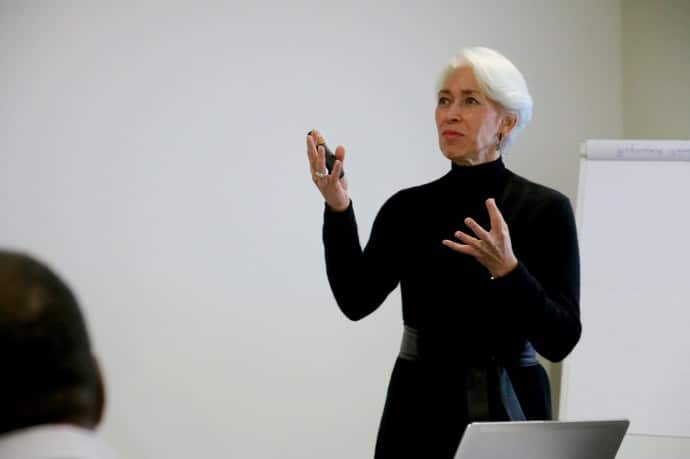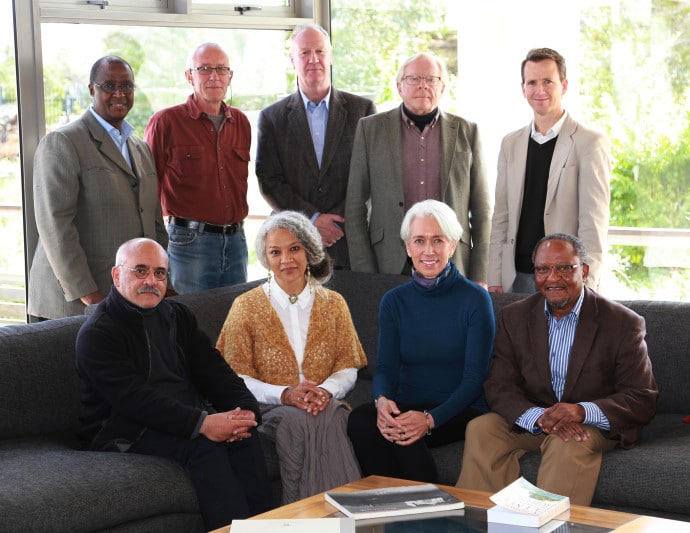“The privileging of light skin colour – both between and within groups – is now recognised as one of the most lamentable cultural universals that exist,” said Prof. Nina Jablonski, Evan Pugh University Professor of Anthropology at Penn State University, member of the American Academy of Arts and Sciences, current STIAS fellow and co-convener of the STIAS Effects of Race (EoR) project. Prof. Jablonski was presenting an update on the EoR project as well as some reflections and excerpts from her personal research on the use of skin lighteners and hair straighteners in South Africa.

“It’s about the use of products for physical transformation,” she said. “We are judged by our physical appearance so products that can change this literally affect people’s everyday lives. You can manipulate others’ perceptions of you by altering your physical appearance.”
The project arose in discussions of major turning points in the history of race and racism in South Africa considered by the larger EoR group. Prof. Jablonski pointed out that the introduction of skin lightening and hair straightening products may seem like an unlikely turning point but the group recognised “that human skin and hair are primary instruments of the human social interface, and that physical appearance is a signifier and a signal. Thus, the introduction of inexpensive products for transformation of appearance toward more European-based norms in the mid-1950s was a major turning point in South African history because skin lighteners and hair straighteners allowed people to negotiate and mitigate the psychological challenges of physical appearance”.
In presenting a brief history of the use of such products, Prof. Jablonski said that ‘lightness’ was associated with higher social status and European influence in most traditional agricultural societies. ‘Passing’ became fairly common in the United States in the late nineteeth and early twentieth centuries after the end of slavery. “A lighter skin was associated with better schooling, job and marriage prospects,” she said. “‘Passing’ meant you could be spared the segregation and shame associated with blackness.”
“Along with this, skin bleaching and hair straightening products became generally available and very popular,” she continued.
African-American performers who toured Africa in the early twentieth century probably influenced the demand for these products in Africa. The products had improved, could be locally produced and therefore became widely available in South Africa in the 1950s leading to a huge surge in popularity.
This coincided with the imposition of Apartheid and, in particular, the Coloured Labour Preference Act.
“Although there is little evidence that people using such products were ever reclassified, their use suggests that they brought benefits – perhaps in social engagements and employment opportunities.”
Many of the products were very injurious to the skin. “But it seems that even potential disfigurement (caused by ochronosis) was seen as a social good,” she continued. Skin lightening products using mercury and hydroquinine were banned in South Africa in the 1970s and 80s, but many were still available illegally.
Paradoxical aspirations
“The huge paradox is that these values and aspirations have persisted since 1994 and such products are still in widespread use,” she said.
“Even during Apartheid it was clear that most people were not trying to ‘pass’ as another race so there was something else going on,” she continued. “It’s important to understand the real mechanisms at work.”
“Scholars remain mystified by the continued and increased popularity of these ideas,” she continued, “many point to the increased influence of celebrity culture and the celebrity icons to whom young people aspire.”
“Young women in particular – but increasingly young men – are encouraged to emulate what is seen as the prevailing standard of physical attractiveness from the dominant world culture.”
“Lighter skin and straighter hair are still seen as more modern and professional,” she said. “Very persuasive advertising, including celebrity endorsement, is a major contributor.”
She also pointed out that many celebrities defend the use of such products by using statements of feminism and personal agency – pointing to their right to control their appearance and change their bodies.
Prof. Jablonski indicated that these practices are prevalent even in predominantly black African countries without South Africa’s Apartheid past. “So it’s important to ask what the perceived rewards are for being ‘white’ in a predominantly black community.” And this is certainly not limited to Africa. There is an even bigger market for skin lightening products in Asia.
“It’s a big, profit-driven business and those who oppose these ideas seem to have much shorter media longevity,” she said.
“It’s important to understand the decisions that affect people’s daily lives and their self-perception when they stand in front of a mirror,” she said. “Individual decisions about appearance are perpetuating old stereotypes. But changing it seems to be like turning a battleship.”
Understanding and eroding the reality of racism
The Effects of Race project was conceived in 2012 as a part of STIAS’s bigger theme ‘Being Human Today’. It brings together a core group of international academics as well as five project groups involving younger scholars established by an RFP process. It is multi-disciplinary including anthropology, education, geography, history, literature, psychology, religious studies and sociology.

The project aims to address gaps in knowledge and to do further research and investigation on race in the context of contesting visions for a democratic South Africa. It aims to catalyse imaginative and innovative approaches to understanding and eroding the reality of racism. The creative and practical projects include educational interventions to mitigate racial thinking.
“Racism is part of the air we breathe in South Africa,” said Jablonski. “What is fascinating is the durability of race, racism and racialism in the face of legislation and scientific knowledge. We need to explain that resilience and tenacity; how hate can be mitigated; and, how a new vision of humanity can be generated.”
Some of the areas which the EOR core projects address include: visualising a South Africa beyond race; the use of blackness during the Rhodes must Fall demonstrations; the underlying geopolitical issues that mobilise racism in South Africa; unscrambling racial constructs in literature; and, trying to understand why despite scientific evidence that all humans are genetically identical the concept of race still persists – why scientific knowledge has not become inculcated into daily life.
Michelle Galloway: Part-time media officer at STIAS
Photos: Christoff Pauw & Anton Jordaan
